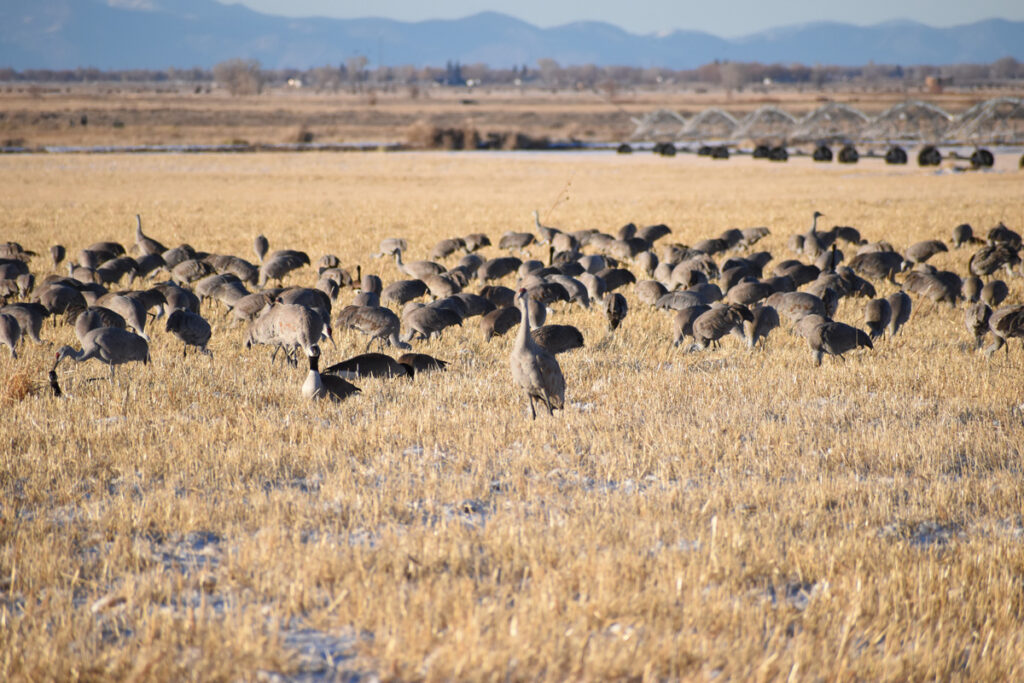
On March 11, I took a trip to Monte Vista, Colorado to see the annual Sandhill Crane migration—they are mking their way northward to Canada and Alaska for their breeding season. The air was alive with their songs, calls lifted up from a group of hundreds of cranes as they fed off refuge-provided grain, shuffled about finding a good resting place, and performed their spectacular mating dances.
For this dramatic display, the male spreads his 6-foot wingspan and leaps up into the air over and over, bellowing out his k-a-r-r-o-o-o call. The highlight for me came when a flock of cranes took off and began circling the grazing field, suddenly joined by another flock, then another, and within seconds a swirling cloud of cranes had covered the sky and filled the air with calls before they all came back down to land—a spectacular performance.
Sandhill cranes mate between the ages of 2 and 8 and will stay with their mate for life, about 30 years. Their dancing isn’t reserved exclusively for mating, as both sexes will hop and flap about while echoing one another’s calls, even outside mating season. Scientists don’t have an exact explanation for this, with some proposing it likely helps strengthen the pair’s bond. They certainly seemed to be enjoying themselves out on the field, socializing and dancing with one another as the last rays of sunlight gleamed off their red-tipped heads.
When they reach their destination by late April, the parents-to-be will find a nice marshy area and create a mound of plant material for a nest, where the female will lay two eggs. Both parents share in incubating the eggs for about a month until they hatch, and the young are ready to leave the nest one day after hatching. The chick will stay with its parents for 10 months and accompany them on the next migration, at which point they are ready to be independent.
These graceful avians were once on the cusp of endangerment from habitat loss and hunting, but have made an incredible comeback and maintained a steady population for years, although this can only be sustained by continued protection of their wetland habitat and field grazing areas. States have also been taking recent action to mitigate light pollution at night, a major cause of disorientation and crashes, with Texas cities adopting a “lights out” campaign during the migratory months, and Nebraska installing UV lights (invisible to human eyes) over power lines to deter cranes from flying into them. Up here in the mountains, these birds get a reprieve from the heavy lights of cities, but it’s always helpful to turn off unnecessary outdoor lights, especially floodlights, during migration season.
By early April, most cranes will be well on their way north, but you can still catch some stragglers grazing and resting in the fields along Highway 159. If you missed the Monte Vista Crane Festival this year, I encourage you to mark your calendar for next year. The sight of hundreds of cranes together dancing and flying about is a breathtaking experience. You can also find them during winter months at Bosque del Apache Wildlife Refuge, near Socorro, NM, where a Festival of the Cranes is held the week before Thanksgiving. These beautiful, complex creatures inspire people across the continent and deserve to be seen, appreciated, and protected.
Author
-

Bryce Flanagan moved from Sacramento, CA to Taos County in 2016, and has lived in Questa for two years. He's passionate about the unique and beautiful wildlife of our state and is a regular contributor to the Questa Del Rio News.
View all posts


